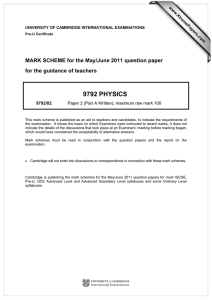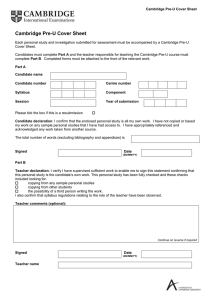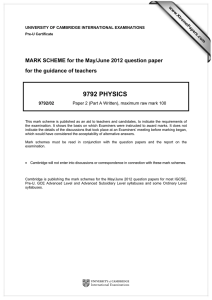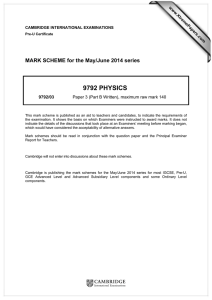9792 PHYSICS MARK SCHEME for the May/June 2014 series
advertisement
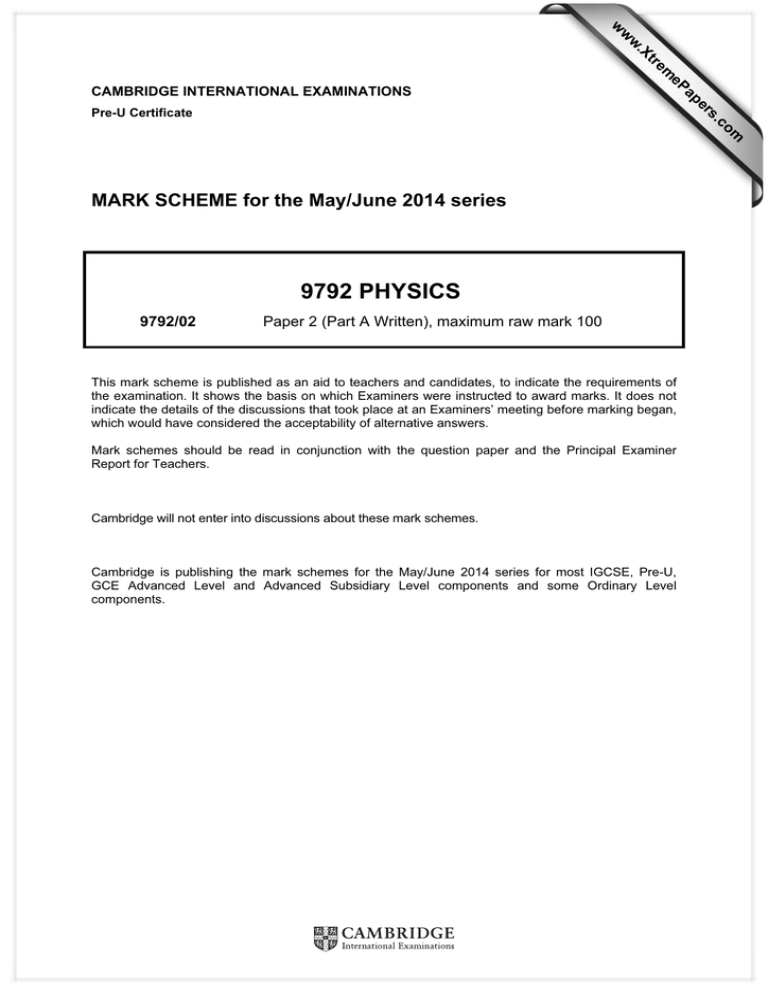
w w ap eP m e tr .X w CAMBRIDGE INTERNATIONAL EXAMINATIONS s er om .c Pre-U Certificate MARK SCHEME for the May/June 2014 series 9792 PHYSICS 9792/02 Paper 2 (Part A Written), maximum raw mark 100 This mark scheme is published as an aid to teachers and candidates, to indicate the requirements of the examination. It shows the basis on which Examiners were instructed to award marks. It does not indicate the details of the discussions that took place at an Examiners’ meeting before marking began, which would have considered the acceptability of alternative answers. Mark schemes should be read in conjunction with the question paper and the Principal Examiner Report for Teachers. Cambridge will not enter into discussions about these mark schemes. Cambridge is publishing the mark schemes for the May/June 2014 series for most IGCSE, Pre-U, GCE Advanced Level and Advanced Subsidiary Level components and some Ordinary Level components. Page 2 Mark Scheme Pre-U – May/June 2014 Syllabus 9792 Paper 02 Section A – 75 marks 1 (a) 0 = 5.62 – 2 × 9.81 × s or s = 1.60 (m) 5.6 (m) [1] [1] [2] 2 × 9.81× 4.8 [1] [1] [2] [1] [1] [2] (b) 2 × 9.8 × (5.6 – 0.8) or 9.7 (m s–1) (c) 9.7 = – 5.6 + (9.81 × t) or t = 15.3 / 9.81 1.56 (s) [6] 2 (a) gravitational field strength is force per unit mass or with symbols defined [1] [1] (b) g is not a force but an acceleration / gravitational field strength [1] [1] (c) resultant force causing acceleration = thrust – weight (76 × 47) + (76 × 9.81) or 4320 (N) 45 400 (Pa) [1] [1] [1] [3] [5] 3 (a) (i) (energy stored =) ½ Fx ½ × 9000 × 4 = 18 000 (J) [1] [1] (ii) total loss of GPE = mgh 68 × 9.81 × 19.39 = 12 900 (J) [1] [1] (iii) stored in rope as elastic potential energy extension is 3.39 m and energy stored = ½kx2 ½ × (9000 / 4) × 3.392 = 12 9000 (J) [1] [1] [1] © Cambridge International Examinations 2014 [7] Page 3 Mark Scheme Pre-U – May/June 2014 Syllabus 9792 Paper 02 (b) any two from: length does not affect (or reach) breaking strain / stress final length / extension ∝ original length GPE lost ∝ original length elastic energy ∝ original length final stress / strain is independent of original length k ∝ 1 / original length does not affect safety margin and two points from above [2] [1] OR constant cross-sectional area of rope stress = force / area and stress not affected by length does not affect safety margin and area unchanged (1) (1) (1) [3] [10] 4 (a) (i) 3.2 and mm [1] (ii) 3.50 – 3.55 and ms [1] (iii) 282 – 286 and Hz [1] (iv) 2.5 – 2.8 squares or 0.5 – 0.56 (ms) 2.5/17.5 – 2.8/17.5 or 0.143 – 0.160 (of a cycle) 0.898 – 1.00 and rad [1] [1] [1] [6] (b) wavelength [1] [1] (c) (i) curve crosses axis at half-way points (by eye) peaks and troughs at half-way points (by eye) and above ± 4 mm [1] [1] (ii) 5.6 – 5.7 mm [1] [3] [10] 5 (a) (i) red / ° green / ° 0 0 0 1 23.6 19.0 2 53 40.5 3 – 77.2 5 values correct 4 marks 4 values correct 3 marks 3 values correct 2 marks 2 values correct 1 marks © Cambridge International Examinations 2014 [4] [4] Page 4 Mark Scheme Pre-U – May/June 2014 Syllabus 9792 (ii) one side correct (GRGRG) same on both sides (b) fuzzy pattern instead of sharp any two from: red bands wider than green bands red bands wider apart than green bands (some yellow bands where) they overlap equally spaced maxima / minima / fringes missing orders Paper 02 [1] [1] [6] [1] [2] [3] [9] 6 (a) 230 × 12.5 or 2875 (W) m × c × ∆θ or 1.50 × 4190 × 83 or 522 000 (J) 181 (s) [1] [1] [1] [3] (b) 1.5 × 2.26 × 106 1180 (s) [1] [1] [2] (c) any two from: heat losses from the kettle kettle needing to be heated up as well as the water some evaporation while water is heating up [2] [2] [7] 7 (a) R = ρl / A π × (0.914 × 10–3)2 / 4 = 6.56 × 10–7 13.0 (Ω) [1] [1] [1] [3] (b) 7.2 (Ω) [1] [1] (c) 12 / (7.2 + 13) or 12 / 20.2 or 0.594 (A) or 7.13 (W) 2.5 (W) [1] [1] [2] (d) current (in the cables) is (much) smaller proportion of the power wasted is (much) smaller / of resistance (much) less [1] [1] OR (total resistance =) 13 + 500 (Ω) or (current = )0.195 (A) p.d. across wire is 2.5 (V) or 0.195 (A) < 0.594 (A) or 2.5 (V) < 7.7 (V) or 13 / 500 < 13 / 20.2 or 0.492 (W) < 4.58 (W) MAX 2 © Cambridge International Examinations 2014 [2] [8] Page 5 8 Mark Scheme Pre-U – May/June 2014 Syllabus 9792 (a) (i) not dependent on anything like pressure, temperature, chemical activity, etc. (ii) cannot predict when a decay will occur (b) (i) 235 1 92 U + 0 n → 236 92 U → 143 54 Xe + Paper 02 [1] [1] 90 38 Sr [2] + 3 01n intermediate nucleus inserted uranium as intermediate nucleus Xe nucleus correct [1] [1] [1] (ii) more neutrons are produced than are used (to start a reaction) one neutron can continue chain or used in subsequent reaction or all but one absorbed (on average) [1] [1] (iii) neutron absorbing material or control rods or boron vary the amount of absorber in the vicinity [1] [1] [7] [9] 9 (a) (i) hc / λ or 6.63 × 10–34 × 3.00 × 108 / 470 × 10–9 4.23 × 10–19 (J) (ii) 2.17 × 10–19 (J) [1] [1] [1] (b) (i) 4.0 × 156 4.6 × 107 [3] [1] [1] (ii) 7.3 × 10–12 (A) [1] (iii) any two from: they are accelerated by an increasing p.d. between (electrodes) more of them [2] [5] [3] [3] (c) any three from: the incoming light (may be) of many different colours any photon with sufficient energy may release an electron output electrons do not depend on incoming colour wavelength information not transmitted in the tube there is current not a wave phosphor plate only produces white light light emitted determined by energy bands/levels in phosphor [11] © Cambridge International Examinations 2014 Page 6 Mark Scheme Pre-U – May/June 2014 Syllabus 9792 Paper 02 Section B – 25 marks 10 (a) (i) 7.98(t – 170) = 4.75t or 7.98t = 4.75(t + 170) or 420 (s) or 250 (s) 7.0 min (accept 7 min) (ii) 1.995 × 103 (km) [1] [1] [1] (b) (i) vibration / oscillation parallel to energy transmission / wave and vibration / oscillation perpendicular to energy transmission / wave energy transferred (in at least one case) (ii) (region centred on point) opposite to epicentre / earthquake (to reach this region) S-waves have to pass though the (outer) core / liquid or S-waves cannot travel through liquids or S-waves absorbed by (outer) core / liquid outer core is liquid (c) (i) speed increases [3] [1] [1] [1] [1] [1] [5] [1] and any two from: temperature increases; density increases; pressure increases; elasticity changes; molecular structure changes [2] (ii) path curves or refracted away from centre of earth or towards surface (allow concave) [1] [1] (d) (i) correct arrow between 45° and 30° to the vertical (ii) sin 90° / sin θ = 13.7 / 8.25 or = 1.66 (θ = )37.0(°) or 143° (iii) waves that just enter the outer core and those that just scrape across its surface (are separated by the refraction in (ii)) leads to a gap between these two positions or shown on diagram and no S-waves on diagram (on surface) © Cambridge International Examinations 2014 [5] [1] [1] [1] [1] [1] [5] Page 7 (e) Mark Scheme Pre-U – May/June 2014 social: locate earthquakes locate landslides warn about tsunamis / volcanoes rush assistance quickly identify archaeological sites save lives / evacuate area academic curiosity identify erosion technological: design buildings that resist earthquakes locate gas / oil reserves locate mineral reserves locate water locate sunken treasure / aeroplane Black boxes / oil tanks (not seismic vibrations used) predict / understand earthquakes / tsunamis / volcanoes economic: cheaper resources no need to replace destroyed buildings discover contamination maximum for question = 7 Syllabus 9792 Paper 02 [1] [1] [1] [1] [1] [1] [1] [1] [1] [1] [1] [1] [1] [1] [1] [1] [7] [25] © Cambridge International Examinations 2014
